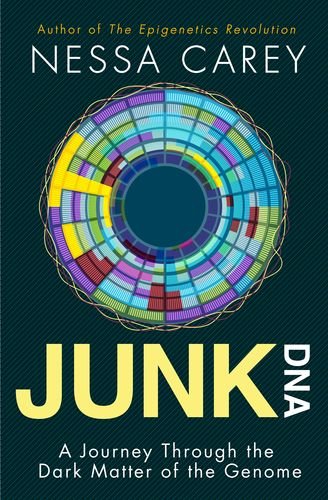
Junk DNA
A Journey Through the Dark Matter of the Genome
کتاب های مرتبط
- اطلاعات
- نقد و بررسی
- دیدگاه کاربران
نقد و بررسی

February 9, 2015
Carey (The Epigenetics Revolution), a visiting professor at Imperial College, London, explores the latest in genomics research and describes, in prose that is for the most part accessible to nonscientists, the complexities of how scientists currently believe the genome works. Two surprising outcomes of the Human Genome Project were the discoveries that humans have only approximately 24,000 functional genes, “pretty much the same quantity as simple microscopic worms,” and that over 98% of the DNA in human cells is “junk,” long stretches that can’t be translated into any proteins. Only recently have scientists began to study this junk, but even at this early stage of understanding, Carey demonstrates that we now know some of the junk DNA may well be partly responsible for terribly debilitating and, to date, intractable disorders such as Duchenne muscular dystrophy, various cancers, and Alzheimer’s disease. She also discusses potential breakthrough drug therapies designed to make use of our growing knowledge of junk DNA to ameliorate or cure some of these devastating conditions. Carey makes two points very clearly: that our understanding is tentative and evolving, and that chromosomal functioning is far more intricate than anyone ever hypothesized. Agent: Andrew Lownie, Andrew Lownie Literary Agency.

February 15, 2015
In referring to junk DNA as the genome's "dark matter," Carey (genetics, Imperial Coll. London; The Epigenetics Revolution) is comparing parallel mysteries facing geneticists and astrophysicists. "Junk," or noncoding, DNA and dark matter/energy comprise more than 95 percent of their environments. The material was once thought to merely take up space, but junk DNA is now viewed very differently. The author describes the many functions of it that have been identified as well as the controversies, contradictions, questions, and possibilities that are arising from ongoing research. She makes extensive use of graphics and especially of analogies, both of which serve to clarify the potentially dense subject matter. Mutations in gene sequences are compared with mistakes in a knitting pattern, for example, and the film Trading Places with its nature vs. nurture theme illustrates what can happen when a well-functioning gene finds itself in a "new neighborhood." Controversies include the dispute over the ENCODE (Encylopedia of DNA Elements) project's data. Does it show clearly that around 80 percent of junk DNA has a function, or does it only suggest potential? VERDICT While not for the casual reader, the book, which is frequently humorous and well documented, does a fine job of explaining a complex subject for lay readers who are willing to put in some effort.--Richard Maxwell, Porter Adventist Hosp. Lib., Denver
Copyright 2015 Library Journal, LLC Used with permission.

























دیدگاه کاربران